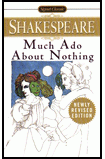Plot
- Create a diagram of flow chart of the four pairs of lovers – Theseus/Hippolyta, Oberon/Titania, Lysander/Hermia, and Demetrius/Helena – and explain how it changes throughout the play to the final pairings. For example, in Act I, scene i, Helena loves Demetrius who loves Hermia who loves Lysander who loves Hermia.
Hermia—>Demetrius—>HermiaLysander - There are at least four story lines in this play. As a follow-up to Activity #1 under While Reading the Play, write a short essay on the uses of plot.
- How does Puck's interference affect what happens in the play?
- As a follow-up to Activity #5 under While Reading the Play, write an essay on Puck as the play's interpreter.
- What is the importance of the forest as the scene of action for most of the play?
- The play begins and ends in Athens. From information gained from Activity #3 under Introduction to the Play, why is Athens an appropriate place for the play to end?
- How does Oberon's interference in the affairs of man further complicate matters?
- How does Shakespeare use the night, the woods, and the fairies to move the plot forward? IF students have read other Shakespearean plays, they can discuss other elements of setting Shakespeare uses to develop his plots. They might discuss why setting is so important to plot.
- What is the overall effect of placing the scenes with the artisans where they are in the play? How is the plot affected?
Characterization
- From Hippolyta's speeches, make a list of what the reader finds out about her. For example, form her first speech we find out she is not as anxious for time to pass as Theseus is. Write a character sketch of Hippolyta using that list.
- How is Helena to blame for the confusion in the woods?
- Compare and contrast Hermia and Helena; Hippolyta and Titania.
- Compare and contrast Lysander and Demetrius; Theseus and Oberon.
- Rewrite the argument between Hermia and Helena in Act III, scene ii, lines 191-344, using modern language.
- Which of the four women is more like a modern-day woman? In what ways is each of them modern?
- Why are the artisans willing to perform for the Duke?
- How does Theseus prove himself to be a wise leader?
- How does Oberon prove himself to be a wise king?
- Make a list of Puck's activities. Write a character sketch of Puck using that list.
- How does Bottom react to the fairies? What does this reflect about his character?
- Explain Demetrius's return to Helena. Was it only because of Oberon's antidote?
Themes
- As a follow-up to Activity #5 under While Reading the Play, write an essay to support Clemen's assertion that the main theme of the play is the transitoriness and inconstancy of love.
- What kind of marriage do Oberon and Titania have? What will the married life of Theseus and Hippolyta be like?
- How does the play about Pyramus and Thisby serve as a model for love?
- Compare and contrast the difficulties of Hermia and Lysander with those of Pyramus and Thisby.
- What is the importance of dreams in this play? How do they affect the outcome?
- What part does friendship play? Is loyalty of importance? How? As a follow-up to Activity #3 in Before Reading the Play, write an essay on friendship as it is exhibited in the play.
Additional Follow-up Activities and Writing Topics
- As a follow-up to Activity #3 under While Reading the Play, write an essay on the ways the word "dream" is used.
- As a follow-up to Activity #4 under While Reading the Play, write an essay on the ways the word "moon" is used.
- Divide the class into pairs or groups of four or five students. Let each group choose a scene (or portion) to present to the class. Students may choose to rewrite their scenes or present them as they are. The following scenes can be used effectively:
- I, i, 20-126 (Egueus, Theseus, Hermia, etc.)
- I, i, 127-178 (Lysander and Hermia)
- I, ii, all (Bottom, etc., casting the play)
- II, i, 60-146 (Oberon and Titania)
- II, i, 188-244 (Demetrius and Helena)
- III, i, 125-202 (Titania and Bottom)
- II, ii 177-344 (Hermia, Lysander, Helena, Demetrius)
- IV, i, 107-202 (Theseus, lovers, etc.)
- V, i, 108-372 (Pyramus and Thisby)
- Let students choose a partner and cast the play from acquaintances, politicians, rock stars, movie stars, etc., giving reasons for their choices and devising a setting for the play such as an outdoor concert, etc.
- Choose a scene from the play to rewrite from the point of view of women's rights.
- Design a display model of the settings for the play, both for Athens and the woods.
- Design costumes for the play in some specific time period other than Elizabethan, such as the roaring twenties, the 1950s, the 1990s, etc.
- Explain how Lysander's statement. "The course of true love never did run smooth" (I, i, 134) fits each of the four pairs of lovers.
- Helena says, "Love looks not with the eyes, but with the mind. And Therefore is winged Cupid painted blind." (I, I, 234-235) How does this statement apply to the four pairs of lovers? To Pyramus and Thisby?
- How does Bottom's line, "reason and love keep little company together nowadays" (III, I, 144-145) fits his relationship with Titania? How might it apply to any of the other lovers—Theseus and Hippolyta, for instance?
- Puck's statement, "Lord, what fools these mortals be!" (III, ii, 115), applies not only to the mortals in the woods, but also to the fairies. Explain.
- Encourage students to read at least two of the eight commentaries then choose one to write an essay on or present as an oral report tot he class. These reports could be done in small group presentations.
- Several film versions of A Midsummer Night's Dreamc are available, including the 1935 version directed by Max Rinehardt and William Dieterle starring Mickey Rooney as Puck; Peter Hall's 1968 film; and Elijah Moshinsky's 1981 BBC film. See one or more film versions of the play, and compare the films to the play.
The Signet Classic edition of A Midsummer Night's Dream has comprehensive bibliographies on Shakespeare's Times, Shakespeare, Shakespeare's Theater, Miscellaneous Reference works, and an excellent one on A Midsummer Night's Dream. Following are additional references, which may be useful in the teaching of the play.
Teaching the Play
Behler, Sharon A. "Teaching Shakespeare's Dramatic Dialogue." In Teaching Shakespeare Today, edited by James E. Davis and Ronald E. Salomone. To be published in 1992 by the National Council of Teachers of English.
Buckle, Linda and Paul Kelley, Editors. Cambridge School Shakespeare: A Midsummer Night's Dream. Cambridge: University of Cambridge, 1992
Clatanoff, Doris A. Teaching Shakespeare in the Elementary Grades. ERIC, 1987.
Durband, Alan, Editor. Shakespeare Made Easy: A Midsummer Night's Dream. London. Stanley Thomes Publishers Ltd., 1989.
Engen, Barbara and Joy Campbell. "Elementary: My Dear Shakespeare." Producing a Shakespearean Festival in the Elementary Schools. Salt Lake City, Utah: Market Masters Books, 1988.
Junior High School English 1 and 2, Grade 9. California: Burbank Unified School District, 1987.
Literature—News That Stays News: Fresh Approaches to the Classics. Classroom Practices in the Teaching of English. 1984. Urbana, IL; National Council of Teachers of English, 1985.
Quattrocki, Edward. "Classroom Presentations of Shakespeare." In Teaching Shakespeare, FOCUS: Teaching English in Southeastern Ohio 2 (May 1976); pp. 26-33.
Three Shakespeare Themes: Love Power, Revenge. The Morgan Bank. Tel Ed Inc., 1987.
Miscellaneous Reference Works
Collins, Michael J. "For World and Stage: An approach to Teaching Shakespeare. " Shakespeare Quarterly 41 (Summer 1990): pp. 251-61.
Davis, James E. and Hazel K., Editors. Teaching Shakespeare, FOCUS: Teaching English in Southeastern Ohio 2 (May 1976).
Davis, James E. and Ronald E. Salomone, Editors. Teaching Shakespeare Today. Urbana, IL: National Council of Teachers of English, to be published in 1992.
Hamilton, Edith. Mythology. New York: New American Library, 1940.
Rosenfeld, Judith B. "An Elizabethan Interlude: A Course for Middle Schoolers." English Journal 76 (December 1987); pp. 49-51.
Salomone, Ronald E., Editor. Teaching Shakespeare, II. FOCUS: Teaching English in Southeastern Ohio12 (Fall 1985).
Switzer, Ellen and Costas. Greek Myths: Gods, Heroes, and Monsters. New York: Atheneum, 1988.
ABOUT THE GUIDE AUTHORHazel K. Davis, teacher of English and Reading at Federal Hocking High School in Stewart, Ohio, has been president of the Assembly on Literature for Adolescents of the National Council of Teachers of English (ALAN) and the Ohio Council of Teachers of English Language Arts. She is a reviewer for The ALAN Review and often speaks and writes on literature for young adults. She is co-editor of the 1988 edition of Your Reading, the junior high/middle school booklist for NCTE.
ABOUT THE GUIDE EDITORS
Arthea (Charlie) J. S. Reed, Ph.D. is a former president of the Assembly on Literature for Adolescents of NCTE (ALAN). She is the author of three books in the fields of literature and teaching: Reaching Adolescents: The Young Adult Book and the School, Comics to Classics: A Guide to Books for Teens and Preteens, and Presenting Harry Mazer. In addition, she is the author or co-author of numerous books in the fieldsof foundations of education and teaching methods. She was editor of The ALAN Review for six years and has co-edited the Signet Classic teacher's guide series since 1988.
In May 1996, Dr. Reed retired after 17 years as a professor of education and six years as chairperson of education at the University of North Carolina at Asheville. After nearly 30 years in teaching at the elementary, secondary, and college/university level, she is now pursuing a new career in education as Executive Director of Development and Education for Northwestern Mutual Life in Asheville, N.C. Dr. Reed and her husband Don live with their two dogs and a cat on a mountain top in Fairview, N.C.
W. Geiger (Guy) Ellis, Professor Emeritus, University of Georgia, received his A.B. and M.Ed. degrees from the University of North Carolina at Chapel Hill and his Ed.D. from the University of Virginia. For most of his career, Guy has been active in teaching adolescent literature, having introduced the first courses on the subject at both the University of Virginia and the University of Georgia. He developed and edited The ALAN Review from 1978 to 1984, changing its focus from a newsleeter to a referred journal. His research has had heavy emphasis on the content of literature instruction.
ISBN: 0-451-52678-3
Copyright © 2000 by Penguin USA
Teachers and readers are welcome to view or print copies of these online guides for classroom and reading group use. But they are copyrighted materials and may not be reposted to other networks, repackaged or resold.
Page numbers reference Penguin Putnam books.














